You’ve likely struggled with uneven granule adhesion or disappointing fusion results in your metalwork projects. Metal granulation demands precise technique across ten critical steps—from selecting compatible alloys to controlling cooling rates. Each phase builds upon the last, and missing even one element can compromise your entire piece. Master these fundamentals, and you’ll transform inconsistent attempts into reliably stunning granulated surfaces that showcase your craftsmanship at its finest.
Selecting the Right Granulation Technique for Your Metal Type

How do you determine which granulation technique will yield the best results for your specific metal? Your success depends on understanding your metal type’s unique characteristics and melting temperature properties.
For fine silver work, pure fusion methods offer superior control due to higher melting points and precise temperature requirements. If you’re working with Argentium silver alloys, you’ll find granulation easier thanks to their extended melting range, allowing successful fusing at lower temperatures than sterling silver.
When granulating gold, choose 24k over 22k—it’s harder and more suitable despite 22k’s wider melting range. Always consider your alloy’s solidus and liquidus temperatures: Argentium 935 melts between 1410°F-1610°F, while sterling silver requires 1475°F-1650°F.
For optimal granulation results, select 24k gold over 22k and carefully monitor your alloy’s specific solidus and liquidus temperature ranges.
Copper content in alloys greatly affects fusing characteristics, making composition analysis essential.
Understanding Temperature Control and Heat Management
You’ll need to master three critical aspects of temperature control to achieve consistent granulation results.
First, implement precise monitoring techniques that track temperature variations within the narrow ranges your specific alloys require.
Next, select heating equipment that provides uniform heat distribution and allows you to manage thermal cycles effectively throughout the entire fusing process.
Precise Temperature Monitoring Techniques
While a few degrees might seem insignificant in most metalworking applications, temperature control becomes absolutely critical when you’re working with granulation since even minor variations can mean the difference between perfect fusion and complete failure.
Your raw materials demand specific attention to melting point ranges—Argentium 935 requires 1410°F to 1610°F, while traditional sterling silver’s solidus and liquidus temperatures range from 1475°F to 1650°F.
You’ll need thermocouples or infrared thermometers for accurate readings. These tools guarantee your granules and base plate heat uniformly for ideal bonding.
Don’t overlook heating duration—overheating causes grain growth and oxidation, compromising both aesthetic quality and structural integrity of your finished piece.
Heating Equipment Selection
Since granulation demands unwavering thermal precision, your heating equipment choice becomes the cornerstone of successful results.
You’ll need torches or kilns that maintain consistent temperature within your alloy’s specific melting range. For Argentium silver, that’s between 1410°F and 1610°F solidus and liquidus temperatures.
Select heating equipment with adjustable settings to fine-tune your process across different alloy compositions. A torch with precise control works best for pure fusion granulation, especially when working fine silver on fine silver.
Your equipment must prevent overheating while ensuring sufficient heat for proper fusing. Continuous temperature monitoring during heating prevents inadequate bonding or complete melting.
Small thermal variations dramatically impact granule fusion, so invest in reliable heating equipment that responds quickly to adjustments and maintains steady heat output throughout your granulation process.
Thermal Cycle Management
Effective thermal cycle management transforms your heating equipment capabilities into predictable, repeatable granulation results.
You’ll need precise temperature management when working with Argentium silver, targeting its solidus point of 1410°F for ideal fusing. Understanding your alloy’s melting behavior is essential—small temperature variations dramatically affect fine silver’s fusion characteristics during granulation.
Focus on achieving uniform heating across both your base plate and granules. Watch for equal shininess on all surfaces before joining, as this indicates proper temperature distribution.
For Liquid Phase Diffusion Bonding, you must maintain temperatures that create both solid and liquid metal phases simultaneously. This allows liquid metal to flow into spaces between granules and base metal.
Timing becomes critical—overheating destroys delicate granules while inadequate heating prevents proper bonding.
Preparing Metal Surfaces for Optimal Bonding
You’ll achieve better granulation results when you properly prepare your metal surfaces before beginning the fusing process.
Start by thoroughly cleaning your base metal using mechanical methods like sanding or chemical solutions to remove oils, dust, and oxidation that can prevent effective bonding.
Your base plate preparation is equally important—ensure it’s smooth, shiny, and matched appropriately to your granule size for ideal heat distribution and adhesion.
Surface Cleaning Methods
Before you can achieve successful metal granulation, you must prepare pristine surfaces that allow for proper bonding between the granules and base metal.
Surface cleaning removes the oxide layer and contaminants that prevent effective fusing during the granulation process.
You’ll need to choose your cleaning method based on your metal type and contamination level. Mechanical abrasion works for light oxidation, while chemical cleaning with acids or solvents handles stubborn residues. For fine silver, nitric acid solutions effectively dissolve surface oxides.
Ultrasonic cleaning reaches intricate areas that manual methods miss.
After cleaning, you must eliminate all moisture since residual water creates steam during heating, disrupting the granulation process. Always rinse with distilled water and thoroughly dry surfaces to prevent new oxidation formation.
Base Plate Preparation
Once your base plate surfaces are clean, proper preparation becomes the foundation for achieving strong, uniform granule bonds.
You’ll need to polish the base metal to create a smooth finish that promotes better adhesion and reduces imperfections. The thickness of your base plate should closely match the diameter of your granules to guarantee uniform heating during the fusing process.
Before adding granules, preheat the base plate to an appropriate temperature. This facilitates proper melting and bonding during granulation.
It’s essential that both the cleaned granules and base plate maintain an equal, shiny appearance before joining. This matching surface quality guarantees ideal fusing results and prevents bonding failures that could compromise your final product’s integrity.
Mastering Torch Control and Flame Positioning
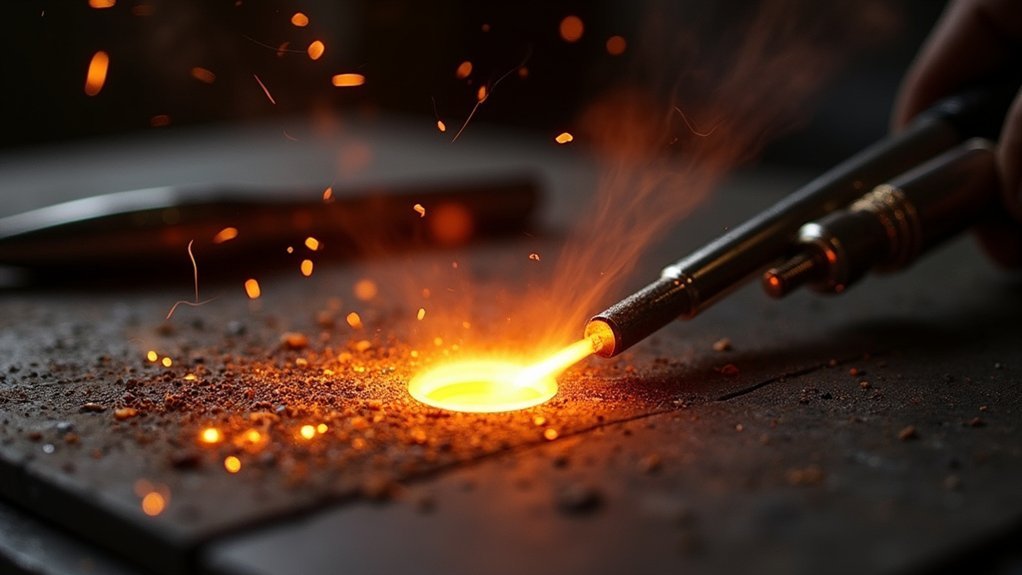
While flame size adjustments might seem straightforward, mastering torch control demands consistent practice to achieve the precise heating that makes or breaks your granulation work. Small variations in flame intensity dramatically impact the granulation process, especially with fine silver.
Perfect flame positioning requires strategic targeting:
Strategic flame positioning separates amateur metalworkers from skilled artisans who understand that precision targeting determines granulation success.
- Direct your flame at the base plate – never aim directly at granules to prevent premature melting
- Maintain 1-2 inches distance from your workpiece for uniform heating distribution
- Use a reducing flame with yellowish hue to minimize oxidation during bonding
- Keep the flame moving to control heat buildup and prevent burning
- Adjust flame angles continuously to guarantee both granules and base metal reach ideal melting temperatures
This disciplined approach prevents excessive thermal buildup while promoting successful granule fusion.
Achieving Proper Granule Size and Uniformity
Why do some granulation projects achieve that coveted professional appearance while others fall flat? The answer lies in attaining proper granule size and uniformity through precise preparation and technique.
Start by cutting metal sheets into consistent pallions—thickness directly affects final granule dimensions. Sort your granules using sieves with decreasing hole sizes to guarantee uniform granule distribution. Match your base plate thickness to granule diameter for ideal alignment and effective joining.
During heating, maintain uniform heating across both base plate and granules. Temperature variations create inconsistent bonding and size irregularities. Add charcoal powder to prevent granules from merging together.
| Component | Key Requirement |
|---|---|
| Pallions | Consistent thickness |
| Base Plate | Match granule diameter |
| Heating | Uniform temperature distribution |
Managing Oxidation and Surface Contamination
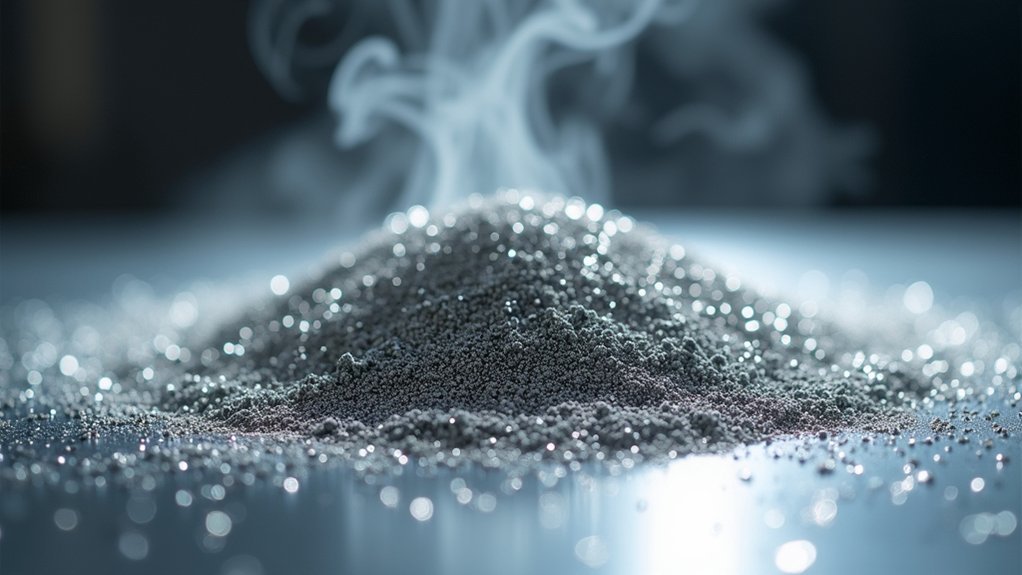
Perfect granule formation means nothing if oxidation and surface contamination compromise your final piece.
You’ve worked hard to achieve uniform granules, but atmospheric exposure can destroy your efforts in seconds. Oxidation creates surface barriers that prevent proper bonding and fusing, while surface contamination introduces impurities that weaken your final product.
Protect your granules with these essential strategies:
- Maintain an inert atmosphere throughout the entire granulation process to eliminate oxygen exposure
- Cool granules rapidly to minimize oxidation time and limit oxide layer thickness
- Apply chemical solutions like copper hydroxide for protective surface coating
- Use pristine tools and materials to prevent environmental contamination
- Monitor temperature and atmospheric conditions continuously for quality control
These protective measures guarantee your granules maintain their integrity for successful metalwork applications.
Timing the Fusion Process for Maximum Adhesion
Even with perfectly formed granules and an oxidation-free environment, you’ll fail without mastering the precise timing of the fusion process. Vital heating phases require constant observation to achieve maximum adhesion.
| Temperature Phase | Visual Indicator |
|---|---|
| Initial heating | Dull surface appearance |
| Approaching fusion | Slight surface shimmer |
| Perfect timing | Equally shiny granules and base |
| Overheating warning | Granule shape distortion |
| Failure point | Complete melting occurs |
You must watch for that vital moment when both granules and base plate reach an equally shiny appearance. For Argentium silver, maintain temperatures between 1410°F and 1610°F. The timing window is narrow—heat just enough to melt granule surfaces while keeping the base solid. Overheating destroys granule integrity and compromises adhesion strength.
Utilizing Flux and Binding Agents Effectively
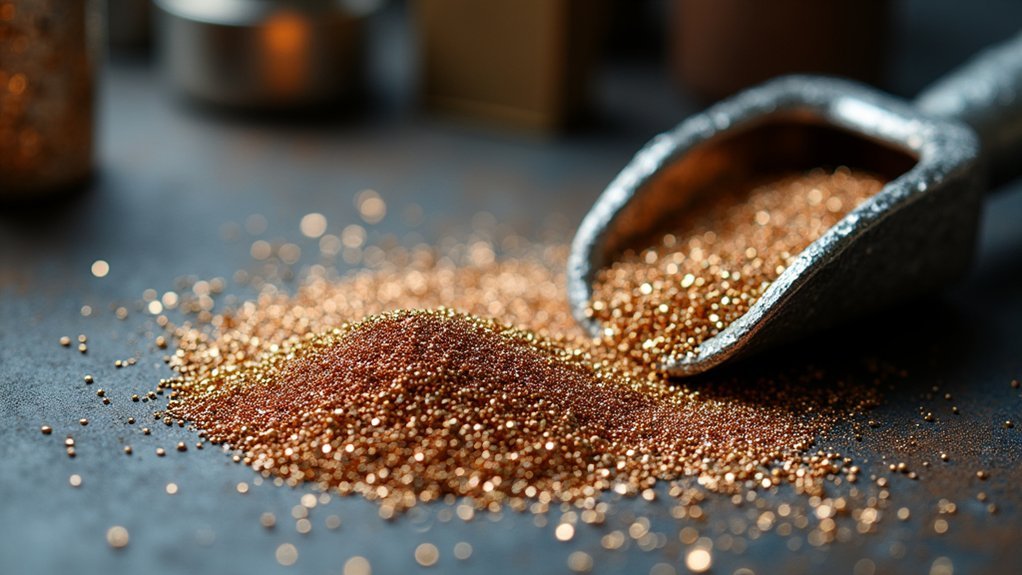
You’ll achieve ideal granulation results by mastering copper hydroxide applications as your primary flux, which effectively lowers melting points while preventing oxidation during the heating process.
When mixing gum Arabic with your granules, maintain a precise 1:1 ratio to guarantee proper cohesion without compromising the individual spherical shapes.
This combination creates the perfect balance between adhesion and structural integrity, allowing you to control the fusion process with greater accuracy.
Copper Hydroxide Applications
Three critical components work together in copper hydroxide applications: the hydroxide itself acts as a chemical solder, binding agents provide structural integrity, and controlled flux reactions create the ideal conditions for granulation.
When you mix copper hydroxide with sodium hydroxide, you’ll create a precipitate that transforms into metallic copper during heating. This process forms a gold-copper alloy that substantially lowers your melting point.
Here’s what makes this technique emotionally rewarding:
- Watch granules bond together like tiny puzzle pieces finding their perfect match
- Experience the satisfaction of achieving that coveted 1:1 ratio with gum Arabic
- Feel confident knowing you’re preventing copper oxide formation through proper technique
- Witness the magical transformation from powder to perfectly fused spheres
- Celebrate consistent results that reflect your growing mastery
Temperature control remains your greatest ally throughout this transformative process.
Gum Arabic Ratios
Building on proper temperature management, achieving the ideal gum Arabic ratio becomes your next priority in creating consistently successful granules.
You’ll want to mix gum Arabic with your granules in a 1:1 ratio to maximize binding properties. This ratio provides excellent cohesion when diluted with water during the granulation process.
Apply your binding solution carefully to prevent excess liquid that causes granules to merge and disrupts intended structure. The gum Arabic creates a cohesive mass that holds everything together during heating, enabling successful metal fusing.
Remember that proper ratios and application techniques directly impact granule formation uniformity.
As you heat the mixture, the binding agent breaks down simultaneously with copper hydroxide reduction, so precise ratios guarantee strong bonds without compromising your final aesthetic quality.
Controlling Cooling Rates and Post-Process Treatment
While achieving proper melting and droplet formation marks an important milestone, controlling cooling rates and implementing effective post-process treatment determine whether your granules meet quality specifications.
Critical cooling control and strategic post-processing separate acceptable granules from those meeting stringent quality specifications for industrial applications.
You’ll need rapid cooling between 50–200°C/sec to minimize oxidation and create ideal microstructure. This critical step prevents undesirable reactions while forming thin oxide layers that enhance granule properties.
Your cooling process success depends on:
- Monitoring cooling medium flow – Poor flow creates inconsistent granule strength
- Controlling droplet size – Irregular sizes lead to weldability issues
- Ensuring uniform base plate heating – Both surfaces must appear equally shiny
- Tracking cooling rates precisely – Wrong temperatures destroy phase distribution
- Reprocessing defective granules – Don’t waste materials with size inconsistencies
Proper post-process treatment corrects surface oxidation issues and size variations that compromise your final product quality.
Quality Assessment and Troubleshooting Common Defects
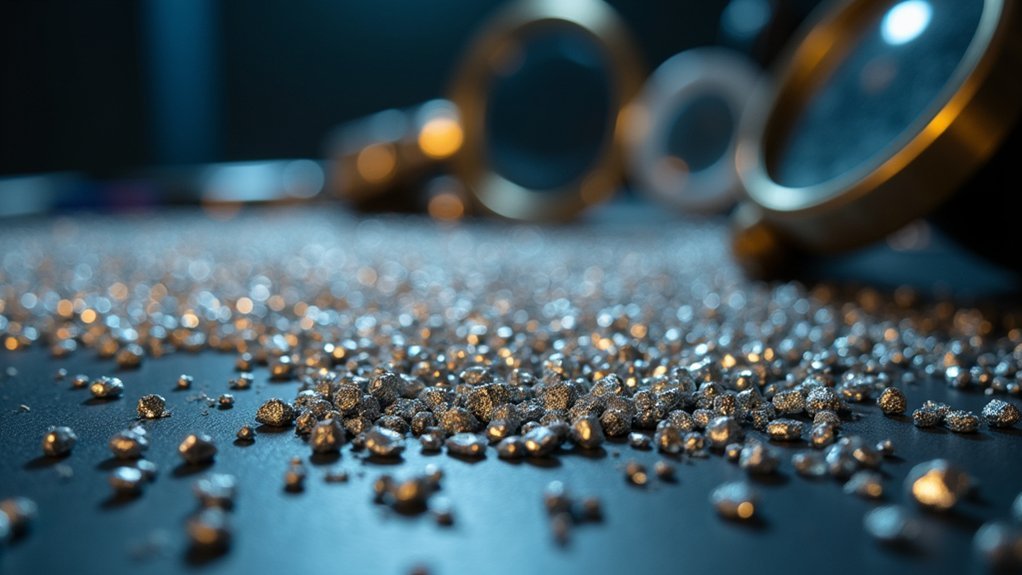
After implementing proper cooling and post-process treatment, you must evaluate your granules against quality specifications to identify potential defects that could compromise performance.
Conduct thorough quality assessment using visual inspection and particle size analysis to examine size distribution uniformity, surface quality, and microstructure integrity.
Watch for common defects including size inconsistency, surface oxidation, and microcracks that stem from inadequate temperature control.
You’ll need to assess granule strength and abrasion resistance to guarantee they withstand handling and processing demands.
Address binder-related issues by adjusting content levels—excessive binder causes overgranulation while insufficient amounts create weak, breakable granules.
Control moisture during drying phases to prevent capping and lamination defects that undermine granule quality.
Frequently Asked Questions
What Are the Steps in the Granulation Process?
You’ll cut metal sheets into pallions, mix them with charcoal powder, heat the mixture at controlled temperatures until granules form and appear shiny, then sieve them by size for uniformity.
What Is the Process of Metal Granulation?
You’ll cut metal into small pieces, mix them with charcoal powder, then heat everything uniformly until shiny. You’re fusing granules to a base plate using precise temperature control without adding extra materials.
What Is the Granulation Technique of Jewelry?
You’ll create small metal granules by heating fine silver or gold pieces with charcoal powder, then fuse them onto jewelry surfaces using precise temperature control without solder for decorative textural effects.
What Is the Most Common Granulation Method?
You’ll find colloidal soldering is the most common granulation method in metalworking. It’s more forgiving than pure fusion techniques, allowing you to bond metal granules easier while maintaining better control over the process.
In Summary
You’ve now mastered the fundamental techniques that’ll transform your metal granulation from amateur attempts into professional-quality work. By controlling temperature precisely, preparing surfaces meticulously, and timing your fusion process correctly, you’ll achieve consistent, superior results. Remember to assess each piece critically and learn from any defects you encounter. With practice and attention to these essential steps, you’ll consistently produce stunning granulated metalwork that showcases your developing craftsmanship and technical expertise.

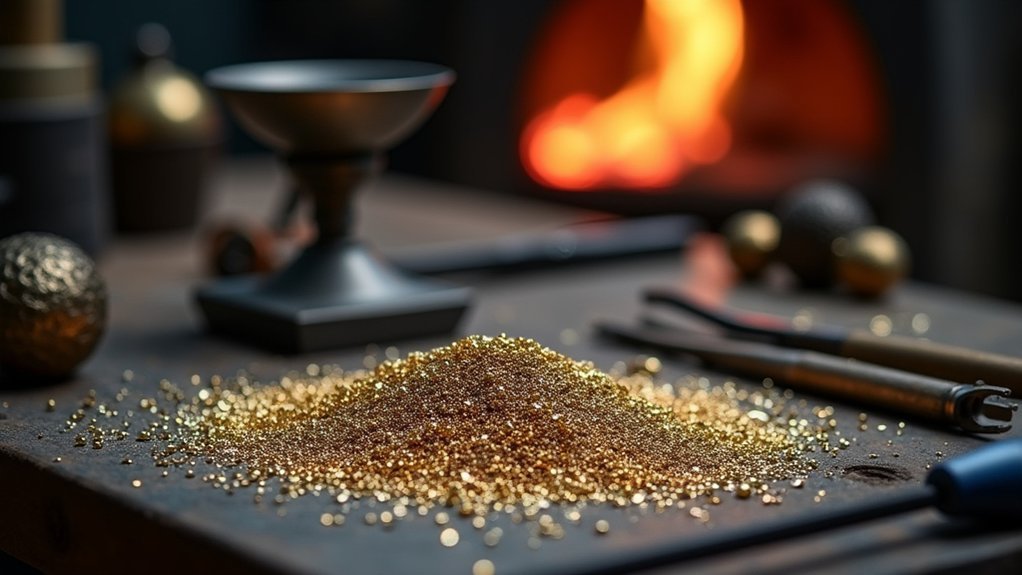
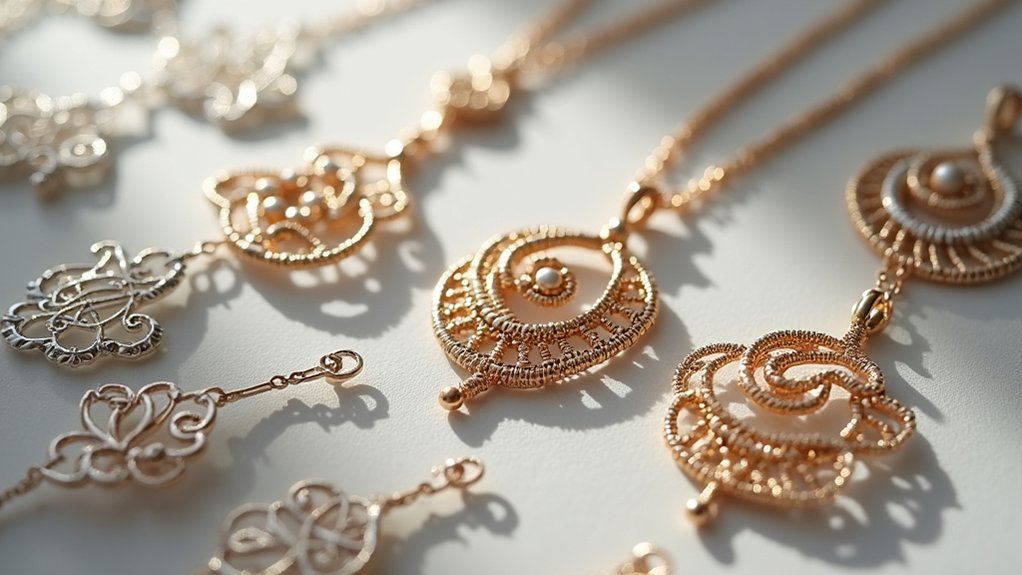
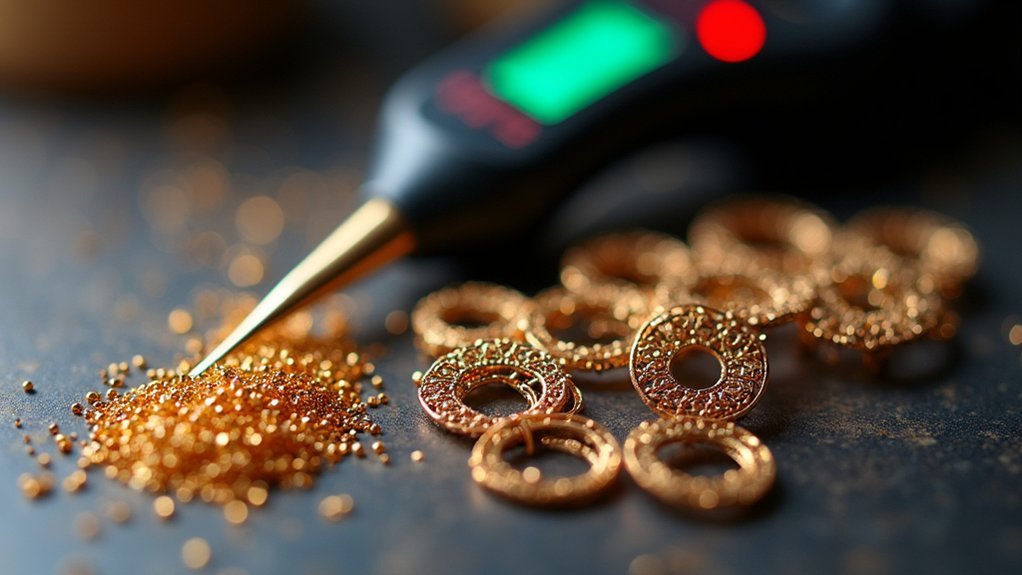

Leave a Reply